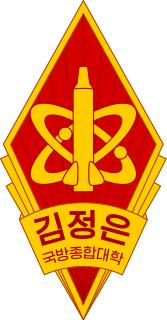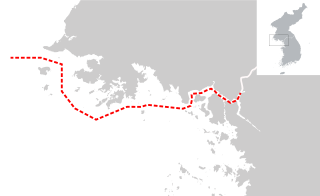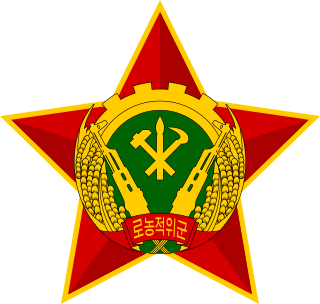 W
WThe Korean People's Army is the military forces of North Korea and the armed wing of the Workers' Party of Korea. Under the Songun policy, it is the central institution of North Korean society. Kim Jong-un serves as Supreme Commander and the chairman of the Central Military Commission. The KPA consists of five branches: the Ground Force, the Naval Force, the Air and Anti-Air Force, the Strategic Rocket Forces, and the Special Operation Force.
 W
WThe Korean People's Army Ground Force(KPAGF; Korean: 조선인민군 륙군; Hanja: 朝鮮人民軍 陸軍; lit. Korean People's Military Land Group) is the main branch of the Korean People's Army, responsible for land-based military operations.
 W
WThe Korean People's Army Strategic Rocket Force, also known as Missile Guidance Bureau is a military branch of the Korean People's Army that oversees North Korea's nuclear and conventional strategic missiles. It is mainly armed with surface-to-surface missiles of domestic design as well as older Soviet and Chinese models. The KPA-SRF was established in 1999 when several missile units under KPA Ground Force Artillery Command were re-organized into a single missile force reporting directly to the office of the Supreme Commander of the KPA via the General Staff.
 W
WThe Korean People's Army Naval Force or the Korean People's Navy (KPN), is the naval service branch of the Korean People's Army, which contains each branch of the North Korean armed forces.
 W
WApril 25 Sports Club, or 4.25 SC for short, or sometimes "April 25 National Defence Sports Club", is a multi-sports club in North Korea based in P'yŏngyang, primarily known outside of North Korea for its men's and women's football teams. The club belongs to the Ministry of People's Armed Forces; all members of the professional teams are considered officers of the Army.
 W
WThe Central Military Band of the Korean People's Army (Korean: 조선인민군군악단), also sometimes known as the Korean People's Army Marching Band or DPRK Army Orchestra is a North Korean musical group/marching band based in Pyongyang and is the sole military band of the Korean People's Army. The Women's Military Marching Band of the Ministry of People's Security of the DPRK is the all female unit of the central band.
 W
WThe Central Military Commission of the Central Committee of the Workers' Party of Korea (CMC) is an organ of the Central Committee of the Workers' Party of Korea (WPK) which is responsible for coordinating the Party organizations within the Korean People's Army (KPA). One of the CMC's primary functions is to authorize defense and munitions spending and product orders, and to determine how natural resources and products from military-controlled production units are earmarked and distributed domestically and for sale abroad. According to the WPK Charter, the CMC directs WPK activities in the KPA and is chaired by the WPK Chairman. The CMC relies on a number of organizations to carry out its mandate, including the KPA General Political Department, the WPK Military Department, and the WPK Machine-Building Department. The CMC also uses the WPK Military Affairs Department to transmit guidance and indoctrination of North Korea's reserve military training units.
 W
WThe Chairman of the State Affairs Commission of the Democratic People's Republic of Korea is the title held by the Supreme leader of North Korea who is the head of state of North Korea. The Chairman heads the State Affairs Commission, which is the highest leadership institution in North Korea, and serves as the commander-in-chief of the North Korean armed forces.
 W
WKim Il-sung Military University is a university located in Mangyongdae-guyok, North Korea. Founded in 1948 and named after Kim Il-sung, the school is a post-secondary educational institution for officers in the Korean People's Army. It is the most prominent military academy in North Korea.
 W
WThe Kim Il-sung University of Politics, also known as the Kim Il-sung Political University, is a university for the training of political officers in the Korean People's Army located in Hyongjesan-guyok, Pyongyang, North Korea.
 W
WThe Kim Jong-un National Defense University is a university located in Ryongsong-guyok, Pyongyang, North Korea. The university focuses on the scientific and technical training of North Korea's national defense personnel.
 W
WThe Korean Armistice Agreement is the armistice that brought about a complete cessation of hostilities of the Korean War. It was signed by U.S. Army Lieutenant General William Harrison, Jr. representing the United Nations Command (UNC), North Korean General Nam Il representing the Korean People's Army (KPA), and the Chinese People's Volunteer Army (PVA). The armistice was signed on 27 July 1953, and was designed to "ensure a complete cessation of hostilities and of all acts of armed force in Korea until a final peaceful settlement is achieved."
 W
WThe Korean Demilitarized Zone is a strip of land running across the Korean Peninsula. It is established by the provisions of the Korean Armistice Agreement to serve as a buffer zone between North Korea and South Korea. The demilitarized zone (DMZ) is a border barrier that divides the Korean Peninsula roughly in half. It was created by agreement between North Korea, China and the United Nations Command in 1953. The DMZ is 250 kilometres long, and about 4 kilometres wide.
 W
WThe Korean People's Army Air and Anti-Air Force is the unified military aviation force of North Korea. It is the second largest branch of the Korean People's Army comprising an estimated 110,000 members. It possesses 940 aircraft of different types, mostly of decades old Soviet and Chinese origin. Its primary task is to defend North Korean airspace.
 W
WConscription in North Korea occurs despite ambiguity concerning its legal status. Men are universally conscripted while females undergo selective conscription. Conscription takes place at age 14; service starts at 17 and ends at 30. Children of the political elites are exempt from conscription, as are people with bad songbun. Recruitment is done on the basis of annual targets drawn up by the Central Military Commission of the Workers' Party of Korea and implemented locally by schools.
 W
WThe National Defence Commission of the Democratic People's Republic of Korea (NDC) was the highest state institution for military and national defence leadership in North Korea, which also served as the highest governing institution of the country from 1998 until 2016 when it was replaced by the State Affairs Commission.
 W
WEvery year, dozens of derelict boats from North Korea wash up on Japanese shores; some of the boats house the remains of their crew. These "ghost ships" are believed to result from when North Korean fishermen are lost at sea and succumb to exposure or starvation.
 W
WThe Northern Limit Line or North Limit Line (NLL) – 북방한계선 – is a disputed maritime demarcation line in the Yellow (West) Sea between the Democratic People's Republic of Korea (DPRK) on the north, and the Republic of Korea (ROK) on the south. This line of military control acts as the de facto maritime boundary between North and South Korea.
 W
WNorth Korea (DPRK) has been active in developing nuclear technology since the 1950s.
 W
WThe Nyongbyon Nuclear Scientific Research Center is North Korea's major nuclear facility, operating its first nuclear reactors. It is located in Nyongbyon County in North Pyongan Province, about 100 km north of Pyongyang. The center produced the fissile material for North Korea's six nuclear weapon tests from 2006 to 2017, and since 2009 is developing indigenous light water reactor nuclear power station technology.
 W
WSohae Satellite Launching Station is a rocket launching site in Tongch'ang-ri, Cholsan County, North Pyongan Province, North Korea. The base is located among hills close to the northern border with China. The spaceport was built on the site of the village Pongdong-ri which was displaced during construction. It was the site for the 13 April 2012 launch of the North Korean satellite Kwangmyŏngsŏng-3, which was launched to celebrate the 100th anniversary of the birth of Kim Il-Sung. The rocket launch failed, but on 12 December of the same year Kwangmyŏngsŏng-3 Unit 2 was successfully launched and brought into Earth orbit.
 W
WThe State Affairs Commission of the Democratic People's Republic of Korea (SAC) is defined by the 2016 constitution as "the supreme policy-oriented leadership body of State power." The current chairman of the SAC, which is defined by the same constitution as the supreme leader of the nation, is Kim Jong-un.
 W
WThe Supreme Commander of the Armed Forces of Democratic People's Republic of Korea is the commander-in-chief of the Korean People's Army, the military of North Korea. The position is vested in the Chairman of the State Affairs Commission in accordance to Article 103 of the Constitution of North Korea.
 W
WThe Tonghae Satellite Launching Ground, also known as Musudan-ri, is a rocket launching site in North Korea.
 W
WThe Worker-Peasant Red Guards, also translated as Workers and Peasants' Red Militia (WPRM), is a paramilitary force in North Korea. It is the largest civil defense force in North Korea. It was established on January 14, 1959 by Kim Il-sung and is not only under State Affairs Commission and Ministry of People's Armed Forces control, but is also attached to the Workers' Party of Korea under its Military Affairs Department.